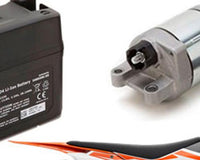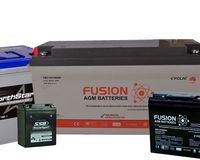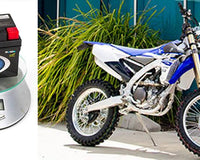Table of Contents
A deep cycle battery is one that can be discharged (up to 80% or more) and recharged multiple times without being damaged. This is in contrast to a maximum of 45% discharge rate recommended for other batteries. It is designed to reliably supply power over extended periods of time.
A normal starter battery, such as a car battery, is designed to give a burst of energy to start up something like a motor.
After starting up a motor, the starter battery power generation is transferred to another source while the alternator recharges the battery to full capacity. This is to ensure that the battery stays fully charged. Such a battery discharges a tiny percentage, usually only up to 5%.
A deep cycle battery, on the other hand, can store up energy for later use, with up to 100% usable capacity.
Deep cycle batteries form a vital part of a range of renewable energy systems. This is because they can deliver low current energy draws over a long period of time.
The difference between a starter lead acid battery and a deep cycle battery is structural. Deep cycle batteries have thicker separators and plates, and denser active material. These thicker plates and separators prevent corrosion that may result from extended charging cycles.
Types of Deep Cycle Batteries
The deep cycle function (ability to discharge and recharge) is not limited to lead acid batteries. The function is also used with Lithium technology. However, lead acid technology is still more widely used.
For starters, deep cycle lead acid batteries can either be flooded or sealed (gel cell or AGM). Each of these battery types differs in functionality. In order to choose the best for your functions, you need to understand their features.
Lithium-Ion Deep Cycle Batteries
The Lithium option is relatively new when it comes to deep cycle batteries. They are 30% lighter than flooded batteries. Additionally, they have 80 to 100% usable capacity. They come with a fast recharge rate and can last up to 5000 charge cycles.
Deep cycle Lithium batteries supply a constant voltage as it discharges. This means that if you are using it to light up a place, the lights stay bright even as the battery discharges and will just go off once the power is out. They will not slowly dim as the charge goes down.
Lithium iron phosphate batteries frequently employ the deep cycle function. They are commonly used in power backup systems or to store solar energy.
While Lithium batteries are maintenance-free, they need a battery maintenance system.
Flooded Lead Acid Batteries
These are the oldest serving batteries. They are made by submerging lead plates in an electrolyte (a mixture of water and sulfuric acid). The resulting chemical reaction reduces the electrolyte level, which needs to be topped up periodically.
Flooded lead acid batteries’ usable capacity is between 30 and 50%. The usable capacity is the amount of charge you can use before the battery needs to be recharged to full capacity to avoid damage.
Flooded batteries require the most maintenance efforts compared to other deep cycle options. You will need to keep adding distilled water to ensure that the electrolyte level is optimal. Additionally, you’ll need to clean acid residue from terminals, covers, and surroundings.
Always keep the battery upright to avoid leakages.
AGM (Absorbent Glass Mat) Deep Cycle Batteries
This is one of the VRLA battery types. The AGM refers to the use of thin fiberglass mats. These mats are placed between the lead plates so as to absorb the electrolyte. This prevents leakage and unnecessary electrolyte movement.
The glass mats act as a damper between the battery’s lead plates. This damper action makes the battery resistant to vibrations and shock. It also gives the battery the ability to withstand low temperatures.
AGM batteries tend to be more expensive than their flooded counterparts. They are generally maintenance-free and are not sensitive to positioning. They are fast-charging, but are sensitive to overcharging, and therefore need a regulated charger.
Gel Cell Batteries
This is another type of Valve Regulated Lead Acid battery. It is made with gelled electrolyte —the typical water and sulfuric acid mix which is suspended in silica gel.
Deep cycle gel cell batteries are costly compared to flooded lead acid batteries. Additionally, they require a special regulator and charger.

Deep Cycle Battery Charging Requirements
The charging parameters vary depending on the type of battery.
Flooded acid batteries require 10% of the Ah rating. This means that if the Ah rating is 100 Ah, 10 amp charging current is needed.
Gel and AGM batteries require 20% of the Ah rating.
| Gel Cell Battery | AGM Battery | Flooded Battery | |
| Absorption charging | 14.2 to 14.4 V | 14.6 to 14.8 V | 14.4 to 14.8 V |
| Float charging | 6.0 to 13.8 V | 13.6 to 13.8 V | 13.2 to 13.5 V |
The battery voltage settings are at 25 degrees. The charging voltages greatly affect battery longevity and performance.
If the charging voltage is higher than what is recommended for that battery type, there is a risk of overcharging. If it is too low, there is a risk of undercharging.
Battery charging time is dependent on the state of charge. For starters, it takes 60% of the indicated charging time to recharge 80% of the battery, and 40% of the time to recharge the last 20%.
Recharging the last 20% of the battery is crucial. It is the stage where sulphation buildup is removed and the battery’s performance is enhanced.
The DC-DC charging settings should always match those of the battery. Recharging a deep cycle battery with incorrect settings can cause leakage due to excessive use of water. It can also cause undercharge, which will result in battery failure.
How Do Deep Cycle Batteries Compare?
The following table shows a simple comparison of four of the major types of deep cycle batteries and their features.
| Flooded Lead Acid Battery | AGM Battery | Gel Cell Battery | Lithium Ion Battery | |
| Depth of discharge | 30–50% | 80% | 75% | 80–100% |
| Charge efficiency | 70–85% | 95% | 85–90% | 85% |
| Sensitive to overcharge | Tolerant | Yes | Highly | Yes |
| Position sensitive | Yes | No | No | No |
| Lifespan | Up to 6 years | 6 years | 10 years | Up to 5000 charge cycles, 3–10 years |
| Charging time | 8 to 16 hours | 5 hours | 5 to 10 hours | 2 to 3 hours |
While each battery type has its own maintenance requirements, there are some general rules when it comes to taking care of a deep cycle battery.
- Allow the battery to cool down after a round of prolonged use so as to avoid grid corrosion
- While some batteries have up to 100% DoD, it is advisable to be cautious so that the charge doesn’t drop below 20%
- Keep the battery terminals and covers clean, dust-free, and corrosion-free
- Be sure to charge the battery even when it is not in use so as to maintain battery life and prevent sulfation
It is advisable to trickle-charge your deep cycle battery. Note that Lithium deep cycle batteries do not require trickle-charge. For best results, get the best quality batteries and follow the manufacturer’s maintenance recommendations.
Deep cycle batteries are best stored in areas of low temperatures. However, most of them function optimally under normal room temperature. Therefore, it is advisable not to refrigerate or use the batteries in extreme temperatures.

Frequently Asked Questions
Can I use a deep cycle battery to start my car?
No.
Deep cycle batteries are designed to deliver low currents over a long period of time. Starting a car needs high current. Using a deep cycle battery to start a car can cause it irreparable damage.
However, if your battery is dual purpose, it means that it is both a starter and a deep cycle. In such a circumstance, it can be used to start a car.
Can I connect different deep cycle batteries to boost output?
No.
You can only connect deep cycle batteries that are of the same type, age, capacity, and model.
What do the deep cycle battery specs mean?
The specifications mainly denote the battery capacity, discharge cycle, and depth of discharge. For example, you can get something like 100 Ah at 20 hours raised 1100 full cycles at 70% DoD.
- Most deep cycle batteries come with a 20-hour discharge rate. Therefore, 100 Ah at 20 hours battery capacity means that the battery can produce 5 Amps (100/20) for 20 hours. If you have more appliances that will be depending on the battery, it is best to get one with a higher capacity.
- 1100 full cycles mean that the battery can be discharged and recharged 1100 times without a decrease in capacity or performance. A high number of cycles means that the battery will last longer.
- 70% DoD refers to how much of the battery capacity you should use before a recharge is needed. A 70% DoD means that you can safely discharge the battery up to 30% of its capacity.
What do I need to consider when buying a deep cycle battery?
The main features to consider are the DoD, Amp hour, and discharge cycle life. Additionally, you need to consider the voltage rating, charging method, charging time, and temperature tolerance.
The durability of the battery will also affect its susceptibility to vibrations, extreme temperatures and shocks. The ideal shelf life of a deep cycle battery is 10 years.

















